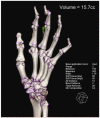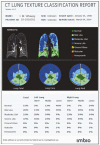Clinical utility of quantitative imaging
- PMID: 25442800
- PMCID: PMC4259826
- DOI: 10.1016/j.acra.2014.08.011
Clinical utility of quantitative imaging
Abstract
Quantitative imaging (QI) is increasingly applied in modern radiology practice, assisting in the clinical assessment of many patients and providing a source of biomarkers for a spectrum of diseases. QI is commonly used to inform patient diagnosis or prognosis, determine the choice of therapy, or monitor therapy response. Because most radiologists will likely implement some QI tools to meet the patient care needs of their referring clinicians, it is important for all radiologists to become familiar with the strengths and limitations of QI. The Association of University Radiologists Radiology Research Alliance Quantitative Imaging Task Force has explored the clinical application of QI and summarizes its work in this review. We provide an overview of the clinical use of QI by discussing QI tools that are currently used in clinical practice, clinical applications of these tools, approaches to reporting of QI, and challenges to implementing QI. It is hoped that these insights will help radiologists recognize the tangible benefits of QI to their patients, their referring clinicians, and their own radiology practice.
Keywords: Radiology; biomarker; quantitative imaging; radiologist.
Copyright © 2015 AUR. Published by Elsevier Inc. All rights reserved.
Figures
























References
-
- Radiological Society of North America [Accessed on January 12, 2014];Quantitative Imaging Biomarkers Alliance. Available at: http://www.rsna.org/QIBA.aspx.
-
- Taylor KJ, Burns PN. Duplex Doppler scanning in the pelvis and abdomen. Ultrasound Med Biol. 1985;11(4):643–58. - PubMed
-
- Pearce WH, Astleford P. What's new in vascular ultrasound. Surg Clin North Am. 2004;84(4):1113–26. vii. - PubMed
-
- Ardalan MR, Tarzamani MK, Shoja MM. A correlation between direct and indirect Doppler ultrasonographic measures in transplant renal artery stenosis. Transplant Proc. 2007;39(5):1436–8. - PubMed
-
- Kruskal JB, Newman PA, Sammons LG, Kane RA. Optimizing Doppler and color flow US: application to hepatic sonography. Radiographics. 2004;24(3):657–75. - PubMed
Publication types
MeSH terms
Substances
Grants and funding
LinkOut - more resources
Full Text Sources
Other Literature Sources

